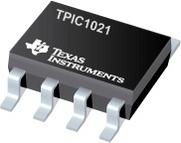The TPIC1021 is the LIN (Local Interconnect Network) physical interface, which integrates the serial transceiver with wake up and protection features. The LIN bus is a single wire, bi-directional bus typically used for low-speed in-vehicle networks using baud rates between 2.4 kbps and 20 kbps.
●The LIN bus has two logical values: the dominant state (voltage near ground) represents a logic 0 and the recessive state (voltage near battery) and represents logic 1.
●In the recessive state the LIN bus is pulled high by the TPIC1021’s internal pull-up resistor (30 kΩ) and series diode, so no external pullup components are required for slave applications. Master applications require an external pullup resistor (1 Ω) plus a series diode.
●The LIN Protocol output data stream on the TXD pin is converted by the TPIC1021 into the LIN bus signal through a current limited, wave-shaping low-side driver with control as outlined by the LIN Physical Layer Specification Revision 2.0. The receiver converts the data stream from the LIN bus and outputs the data stream via the RXD pin.
●In Low Power mode, the TPIC1021 requires very low quiescent current even though the wake-up circuits remain active allowing for remote wake up via the LIN bus or local wake ups via NWake or EN pins.
●The TPIC1021 has been designed for operation in the harsh automotive environment. The device can handle LIN bus voltage swing from 40 V down to ground and survive –40 V. The device also prevents back feed current through the LIN pin to the supply input in case of a ground shift or supply voltage disconnection. It also features under-voltage, over temperature, and loss of ground protection. In the event of a fault condition the output is immediately switched off and remains off until the fault condition is removed.
● LIN Physical Layer Specification Revision 2.0
●compliant. Conforms to SAEJ2602 Recommended
●Practice for LIN
● LIN Bus Speed up to 20 kbps
● ESD Protection to 12 kV (Human Body Model) on
●LIN Pin
● LIN Pin Handles Voltage from –40 V to 40 V
● Survives Transient Damage in Automotive
●Environment (ISO 7637)
● Operation with Supply from 7-V to 27-V DC
● Two Operation Modes: Normal and Low-Power
●(Sleep) Mode
● Low Current Consumption in Low Power Mode
● Wake-Up Available from LIN Bus, Wake-Up Input
●(External Switch) or Host MCU
● Interfaces to MCU with 5-V or 3.3-V I/O Pins
● Dominant State Timeout Protection on TXD Pin
● Wake-Up Request on RXD Pin
● Control of External Voltage Regulator (INH Pin)
● Integrated Pull-Up Resistor and Series Diode for
●LIN Slave Applications
● Low EME (Electromagnetic Emissions), High EMI
●(Electromagnetic Immunity)
● Bus Terminal Short-Circuit Protected for Short to
●Battery or Short to Ground
● Thermally Protected
● Ground Disconnection Fail-Safe at System Level
● Ground Shift Operation at System Level
● Unpowered Node Does Not Disturb the Network


